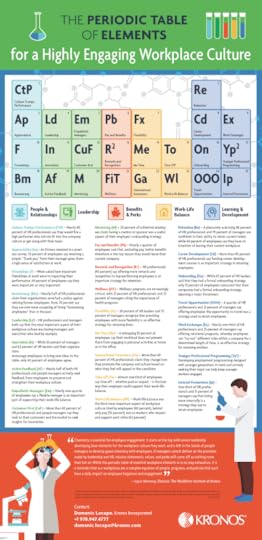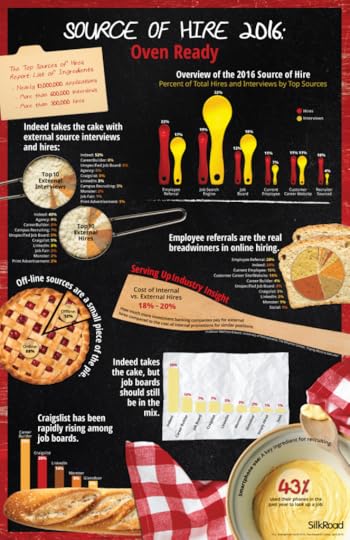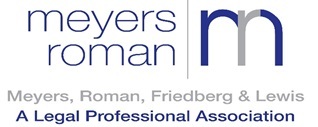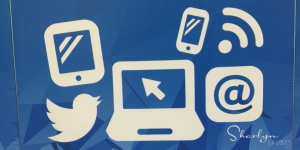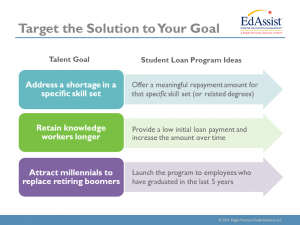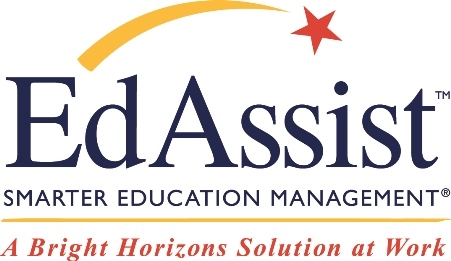Sharlyn J. Lauby's Blog, page 156
June 9, 2016
Company Purpose and Passion Drive Bottom-Line Results
Several weeks ago, I published a post titled, “Company Purpose and Passion Are Always Changing.” The post focused on organizations engaging employees by making a connection between their work and the company’s purpose. Employees want to see how their work impacts the organization and customers.
A Facebook reader sent me a note. I’ll paraphrase it. “Senior management doesn’t want sappy conversations about purpose and passion. They want immediate action and immediate results.” I totally agree that management wants action and results. No question about it.
And some managers might not want “sappy” conversations. I get it. But I do believe that managers want to talk about company purpose and passion. The question becomes, are managers talking about it directly? Here are a couple of examples:
Human resources conveys company purpose and passion in the candidate experience. I’ve seen a couple of articles lately talking about whether or not organizations benefit from having a human resources department. Fast Company published a piece about the challenges of replacing HR with software. And Chris Fields wrote a piece on the difficulties with outsourcing HR. They’re both good reads. The reason I mention these articles is because, often, HR is given the task of communicating company purpose and passion.
So senior management might not be directly discussing purpose and passion. But they are on display in a career portal, discussed during job interviews, and incorporated into onboarding programs. Candidates want to know what kind of company they’re applying to and going to work for. Purpose and passion answer the question.
Managers use different words to explain the concepts of purpose and passion. It’s possible that instead of managers saying:
“It’s our company’s purpose to …”
“Our company’s passion is to …”
They say, “Our goal is to …” and “Our strategy is …”
Because purpose and passion ARE about results. President Obama, in a commencement address at Howard University said, “Passion isn’t enough; you have to have strategy.” While the statement was made in the context of being an active citizen and participant in community activities, the statement has value in business. Because, for passion to be valuable, it must be combined with action.
Regardless of whether managers are using the words, I believe that business leaders are talking about purpose and passion. It’s how they communicate strategy. And the messaging happens pre- and post-hire. However, with any kind of messaging it’s important to remember that it must be delivered in an authentic and transparent manner using mediums that the audience will embrace.
Image taken by Sharlyn Lauby after speaking at the Flora Icelandic HR Management Conference in Reykjavik, Iceland
The post Company Purpose and Passion Drive Bottom-Line Results appeared first on hr bartender.






June 7, 2016
A Highly Engaged Workplace Culture: Essential Elements
(Editor’s Note: Today’s post is brought to you by Kronos , the global leader in delivering workforce management solutions in the cloud. Kronos has launched a new workforce analytics as a service offering that allows small and midsized businesses to understand how labor hours are being spent by visualize workforce data using interactive technology. Enjoy the post!)
You guys know I’m a long-time volunteer leader with the Society for Human Resource Management (SHRM.) One of the volunteer roles I held was chair of the HR Florida Conference. The conference theme during my year as chair was “The Art of Human Resources.” After reading the third and final study from The Workforce Institute at Kronos, it looks like there’s a little science to HR as well.
As a reminder, the last study focused on who owns culture. The short answer: we all do, but that shouldn’t stop you from checking out the data. In this study, respondents identified the 25 essential elements of an engaged company culture. Because owning culture and the elements of it are two very different things.
There are five major areas in company culture: relationships, leadership, compensation, work, and learning. There’s a lot more information in this report so be sure to take a look at the complete findings. Here are some interesting results to note:
HR professionals claim their organizations used to have policies against rehiring employees, but with talent wars heating up, seventy-six percent (76%) indicate they’ve become much more accepting of boomerangs.
There’s a major disconnect with onboarding. Sixty-seven percent (67%) of HR professionals say they have a formal onboarding process compared with 13 percent (13%) of employees.
Nearly 25 percent of employees say having an empathetic and flexible manager is an important part of their work-life balance.
Wellness programs are increasingly popular, with almost a quarter of respondents citing their importance.
One-third of employees say time off is the best way their organization can support their work-life balance.
The real takeaway for me was that company culture has so many elements. And those elements are dynamic – both as a single element and combined with other elements. It’s like the periodic table. The Kronos graphics team did a fantastic job of representing culture like the periodic table.
If we think about company culture like the periodic table, then we use the analogy to encourage managers to be like a chemist. The science nerd in me says this could be a new and fun way to present classic messaging about the importance of company culture. For example:
Create your own company culture “periodic” table. Whether it’s literally or figuratively, make sure everyone in the organization understands what makes up the company culture and how they contribute to it. This can take place on career sites, during onboarding, and at company training.
Use the individual elements to design formulas for success. Think back to chemistry class for some of the common compounds we learned. For example: rubbing alcohol is also known as isopropyl alcohol and known by the chemical formula (CH3)2 And laughing gas is dinitrogen oxide represented by the formula N2O. Apply the same idea to the workplace.
Work-Life Balance happens when managers are empathic and flexible regarding “me” time. The formula for work-life balance is WI = Em + Fx + Me.
Employees stay with companies when they have friends at work, are appreciated for a job well done, and receive career development opportunities. The formula for Retention is Ap + F + Cd.
As human resources professionals, we have to find new ways to communicate the same messaging to our audience. I don’t think it’s a surprise that concepts like work-life balance are important to employees. But packaging the conversation a little differently could resonate in a way that may not have in the past. Or simply add a “big bang” to a concept that’s already working.
As I mentioned, this post only scratches the surface of the data presented in the report. Be sure to download the full report from The Workforce Institute website. Also you can listen to a couple of related podcasts on “Who Owns Company Culture?” and “Kronos CEO Aron Ain on the Importance of Workplace Culture.” The culture conversation isn’t going away anytime soon.
The post A Highly Engaged Workplace Culture: Essential Elements appeared first on hr bartender.






June 5, 2016
What Job Title Should I Use On My Resume – Ask #HR Bartender
Job titles can sometimes be confusing. In some organizations, they are taken very literally and can tell people internally and externally about your role and responsibilities. In other places, they can have some whimsy which may reflect the company culture. Sometimes the job title on your employee paperwork isn’t the same as what’s on your business card. So how do you know the best title to put on your resume? That’s what this reader wants to know.
Hi Sharlyn. I came across your YouTube videos and was wondering if you’d be able to answer a question. I’m currently working on my resume and am a little unsure as what to list as a job title at my current employer. For 2 years, I was a manager and due to a company restructuring, my position was changed to clerk, where I have been for the past 4 years. I don’t want to lie to prospective employers. Should I put manager, clerk, or a combination like manager/clerk on my resume?
This isn’t an unusual question. Our resume is a summary of our career. To be effective, we want it to really grab a recruiter’s attention. So I asked a couple of my friends who write resumes and provide career advice to share their thoughts. Jacqui Barrett-Poindexter is a Master Resume Writer (MRW) and owner of CareerTrend, a professional resume writing service. Chris Fields is an expert resume writer and human resources consultant who assists job seekers with their resumes, cover letters, LinkedIn profiles and job search over on ResumeCrusade.com. Chris and Jacqui have shared their expertise with us before and I’m thrilled they offered to help with this situation.
Jacqui, I get asked this question a lot. Should a person list ALL of their job titles on their resume? Why or why not?
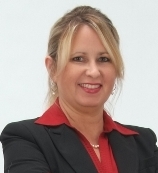 [Jacqui] You should list most/all job titles for the most recent 10-15 years’ experience. Prior to that, you can simply summarize achievements without listing job titles. It is okay to omit very short-term roles; i.e., a few months or less than a year in duration.
[Jacqui] You should list most/all job titles for the most recent 10-15 years’ experience. Prior to that, you can simply summarize achievements without listing job titles. It is okay to omit very short-term roles; i.e., a few months or less than a year in duration.
Since a resume is a marketing document, and not a legal document, the key is to be forthright, while also positioning yourself in the best light. In other words, if your most recent role is not indicative of your value, and an immediately prior role at the same company – in this case, the ‘manager’ role – speaks more to your competitive value, then make sure THAT role is showcased and the clerk title is downplayed. For example:
The key with the above example is to NOT omit the clerk title, but also not lead with it. Tone down that fact and play up your value proposition. Also, if after the restructuring, you still held responsibilities from the Manager role, you want to leverage that fact and not get mired down in the change in title.
Chris, on the other hand, does a person have to list ANY job titles on my resume? What are the advantages / disadvantages?
 [Chris] This is a very good question and, believe it or not, more and more people are in this situation. With different companies using different titles, the words and jargon have changed quite a bit. Also, as in this example a merger, acquisition or realignment can cause someone to get a lesser title by no fault of their own. And consider this, some companies will use titles to compensate you, so this is a big deal.
[Chris] This is a very good question and, believe it or not, more and more people are in this situation. With different companies using different titles, the words and jargon have changed quite a bit. Also, as in this example a merger, acquisition or realignment can cause someone to get a lesser title by no fault of their own. And consider this, some companies will use titles to compensate you, so this is a big deal.
Here is my best advice for handling this situation. First, use the official title that the company has listed for you just in case someone calls for a background check so it’s not misleading. However, on your resume in parenthesis you can put the title that more accurately describes your day to day job duties, for example, AMC Corp., Clerk (Manager) or another option is to list the title and duties before the restructuring and then the title and duties after the restructuring. It’s perfectly okay to have a bullet point that reads ‘Same duties as Manager, title change due to corporate reorganization (or realignment.)’
And yes, you should list your job titles and the company names on your resume because without those, it looks suspicious; as if you have something to hide and that’s never a good thing in the job market.
Be as honest as possible on your resume because as you know most recruiters and hiring managers screen resumes very quickly and anything that looks suspicious or questionable usually does not make it the next level. Remember, you can use your cover letter to explain changes in the titles or duties.
If I can only list ONE job title, which one should it be – the “last” one or the “best” one?
[Jacqui] I would list a blended job title; i.e., ‘Manager/Clerk’ or ‘Manager, Clerk’ (if the ‘/’ causes an issue). I cannot see any situation where you wouldn’t be allowed to enter your title as such.
[Chris] Let’s talk about tweaking job titles. You may think I’m going to say ‘no’ to this one but I’m not. It depends. The first rule to tweaking job titles is to never tweak upward, meaning don’t change or tweak your title to a bigger position. So basically, don’t give yourself a promotion. However, if you are listed as an office coordinator or assistant, it’s okay to use administrative assistant, because they are the same thing – same duties.
Speaking of tweaking, if have a job title that might not be instantly recognizable (like Facilities Coordinator II or Marketing Administrator III), is it okay to tweak it a little?
[Jacqui] Yes. I would include the actual title (as recorded at your company’s human resources) in parentheses. In front of the parentheses, write out the instantly recognizable, more typical or even the more targeted title (toward your goals, if doing so is an honest representation of work you performed).
For example, using Marketing Administrator III as an example, you could write:
Digital Marketing Manager (Marketing Administrator III)
Brand Manager (Marketing Administrator III)
Marketing + Social Media Director (Marketing Administrator III)
Marketing Development Manager (Marketing Administrator III)
Marketing Analyst (Marketing Administrator III)
[Chris] Here are four rules to sum up job titles:
Best practice is to use the title the company uses for you – you can alter it if your job duties and accomplishments actually support it.
If your job title changes due to reorg, realignment, merger, or title demotion you can separate it on your resume.
It’s okay to tweak your job title or modernize it as long as you are not giving yourself a promotion or higher title.
Remember titles are still tied to compensation so when you outwork your job description be sure to get the proper compensation. It’s important for your future as well.
Again, my thanks to Chris and Jacqui for sharing their knowledge and expertise with us. Be sure to check out their blogs at The Resume Crusade and CareerTrend. You can also follow them on Twitter at @ResumeCrusade and @ValueIntoWords.
If you’ve ever wondered if you should hire a pro to craft your resume, this is exactly the reason.
Image taken by Sharlyn Lauby at the Las Vegas Mob Museum
The post What Job Title Should I Use On My Resume – Ask #HR Bartender appeared first on hr bartender.






June 3, 2016
Ingredients For Recruiting Success [infographic] – Friday Distraction
The reason I named this blog HR Bartender was because, as an HR professional, I always thought people wanted me to act like a bartender – listen, support and offer a suggestion when appropriate. One of the other things bartenders do is mix drinks – meaning they take a variety of ingredients and put them together to create something tasty.
HR professionals do the same thing with strategy. Take recruiting for example. We put together the right mix of ingredients (i.e. job board posting, referrals, etc.) to produce the desired result. Our friends at SilkRoad understand this and put together a clever infographic on the right ingredients for successful recruiting.
Couple of statistics that caught my eye:
Employee referrals remain an important part of an organization’s hiring strategy. This should not be a “set it and forget it” policy. Companies need to review it regularly to make sure it doesn’t go stale.
While Indeed is dominating the external sources, other job search engines and boards can bring value if they’re used strategically.
And mobile cannot be ignored. Forty-three percent (43%) of respondents have used their phones to look up a job.
I continue to hear from human resources professionals that finding qualified candidates is a top priority and a top challenge. Organizations will have to start changing up their recipe. Maybe add a new ingredient. Or find a substitute when they don’t have something on hand (like using external recruiters.) That’s not a bad thing. Organizations could even find that their new recipe is better than the old one.
The post Ingredients For Recruiting Success [infographic] – Friday Distraction appeared first on hr bartender.






June 2, 2016
Workforce Development Should Be Part of Your Recruiting Strategy
There’s a lot of talk about the challenges of finding qualified applicants. And I realize when the conversation becomes this prevalent, it can be tempting to tune it out. But, I want to talk about something different that can impact your recruiting strategy.
That’s job creation and job readiness. Both are activities that happen at your local workforce development board (also known as a workforce investment board.)
Several years ago I received an invitation to join our local workforce development board. My first thought was “Good grief, what does this have to do with me?” But I accepted the invitation and served on the board for several years. I learned a lot. Let me repeat that…I learned a lot. Here are a few of highlights:
Partnerships are essential. Two key alliances are with economic development and education. Workforce boards work closely with their economic development counterparts to ensure businesses have access to talent. They also work with schools, colleges and universities to make sure certain jobs that are essential to the community have available curriculum.
Workforce board funding is incredibly complex. The money comes from the federal government (via each state). The two major sources are the Workforce Investment Act (WIA) and Temporary Assistance for Needy Families (TANF). When I was on the board, we were keenly interested in everything that pertained to this funding. Interestingly enough, today I hear very little about the importance of these funding streams and the need to make sure workforce boards are fully funded.
Workforce spending is specific. Meaning that most of the time, workforce boards cannot spend funding on whatever they want. Or in some cases what their community needs. See the problem? Each funding stream has very specific rules about how the funds are spent. This is why you might hear in some communities about training dollars being exhausted but other funds being available – just not for training.
The reason I wanted to share with you some of my insights from serving on a local workforce development board is because I heard the same conversation during the Society for Human Resource Management (SHRM) Talent Management Conference. If you’re not aware, SHRM Government Affairs takes time during conferences to conduct listening sessions and I was invited to one focusing on the challenges HR pros are having finding skilled trades workers.
This wasn’t my first listening session. Last year, I had the chance to be a part of a conversation about the Affordable Care Act (ACA). Kelly Hastings, senior government relations advisor at SHRM, explained that the listening sessions help the association craft position statements on behalf of the membership. If you have the opportunity to participate in a future session, I would strongly suggest you do. It’s a chance to give your professional association the point-of-view of your company and industry. And that’s something SHRM wants to hear.
While it wouldn’t be appropriate to talk details about the listening session that took place, let me say that workforce development boards can have a positive impact on your recruiting strategy. Especially when it comes to skilled trades workers. But they need your help. Human resources professionals should partner with them, learn how they operate, and understand their complex systems. In return, organizations can leverage their understanding of the system to tap into the talent they are so desperately are looking for.
P.S. Speaking of workforce development, one of the biggest champions in this area is Mike Rowe, who will be speaking at this year’s SHRM Annual Conference. The mikeroweWORKS Foundation is working to close the skills gap and challenging the notion that a 4-year college degree is the only path to success. I know I’m looking forward to his session. Hope to see you there!
The post Workforce Development Should Be Part of Your Recruiting Strategy appeared first on hr bartender.






May 31, 2016
Should Millennials Be Concerned About Age Bias – Ask #HR Bartender
The regular conversations about generations in the workplace raise an issue for candidates, employees, and employers – age bias. It might also be a first reaction to think age bias only happens to older people. But that’s not necessarily true. Today’s reader note explains:
I’m starting to look for a new job. I am 29 years old and graduated with my business degree 3 years ago. I’m concerned that my age will affect my chances of getting an entry level management job. I’ve had supervisory positions in the past. Is having experience an advantage? Versus competing for a job with people who are fresh out of college? Maybe the age thing is just something in my head? Any advice you can give would be greatly appreciated.
Even though this note is about age, there are several different facets involved. So I asked Jon Hyman, partner in the firm Meyers, Roman, Friedberg & Lewis based in Cleveland, Ohio if he would share his knowledge. Jon is also the author of the Ohio Employer’s Law Blog, which is in the American Bar Association’s Blawg Hall of Fame and which the ABA has recognized for the past six years as one of the top 100 legal blogs. You might recall that Jon has helped us out in the past with a post on unfair labor practices.
As always, please remember that Jon’s comments should not be construed as legal advice or as pertaining to specific situations, such as the one described above. Nothing he says here will create an attorney-client relationship. Jon is doing this for free; he gets paid to be a lawyer. Now that we’ve gotten all that out of the way…
Jon, let’s make sure everyone reading this post is on the same page. In the U.S., we have a law protecting people from age discrimination. Can you briefly describe the Age Discrimination in Employment Act (ADEA) ?
 [Hyman] The ADEA protects employees age 40 or older from discrimination in employment. Discrimination is defined as better treatment by an employer of someone who is ‘substantially younger.’ Courts are all over the map on what it means to be ‘substantially younger,’ and some have used age gaps as low as five years, some go as high as 10 as the minimum. What’s important to know, however, is that the substantially-younger rule does not require the better-treated employee to be younger than 40. As odd as it may seem, it is still age discrimination if you treat a 65-year-old employee better than a 75-year-old employee because of their age. The ADEA also prohibits age-based harassment on the job.
[Hyman] The ADEA protects employees age 40 or older from discrimination in employment. Discrimination is defined as better treatment by an employer of someone who is ‘substantially younger.’ Courts are all over the map on what it means to be ‘substantially younger,’ and some have used age gaps as low as five years, some go as high as 10 as the minimum. What’s important to know, however, is that the substantially-younger rule does not require the better-treated employee to be younger than 40. As odd as it may seem, it is still age discrimination if you treat a 65-year-old employee better than a 75-year-old employee because of their age. The ADEA also prohibits age-based harassment on the job.
Technically speaking, a person in their 20’s isn’t protected by the law. But does that mean they shouldn’t be concerned about age-based employment decisions?
[Hyman] That’s a very interesting question. Yes, the ADEA does not protect anyone age 39 or younger. But it does not mean that Millennials shouldn’t be concerned about age. Age can be synonymous with experience. If a position requires a certain level of experience, a younger worker very well may be a competitive hiring disadvantage. That disadvantage, however, is not discriminatory.
Career advisors often tell job seekers to remove information on resumes that might give an indicator of how old someone is – for example, don’t put the year you graduated from college. What are your thoughts on this practice? If in favor, what would you definitely leave off a resume?
[Hyman] Age-based information should not appear on a resume, job application, or other information an applicant submits to a prospective employer for consideration. This not only includes date of birth, but other dates from which one could infer age, such as graduation dates or dates of licensure. You should let an employer know the degrees and licenses you hold, but when you obtained them is not relevant (at least not until you receive a conditional job offer and the employer is attempting to confirm the veracity of your degrees and licenses in a background check).
We’ve talked about a couple of things candidates need to keep in mind. What about companies – how can companies make sure that age isn’t implicitly being considered in employment decisions?
[Hyman] Training, training, training. It’s all about the training. Recruiters, interviewers, hiring manager, and others involved in the hiring process must understand how to avoid age-based bias. It’s easy to understand, ‘Don’t ask someone how old they are?’ It’s harder to understand some of the subtler and nuanced questions that could reveal one’s age, such as ‘How many years until you plan to retire,’ and ‘How many years seniority did you have at your prior company?’
Everyone involved in the hiring process must understand how to avoid age bias – @JonHyman
Click To Tweet
It’s also important to avoid stereotypes in job listings and advertisements (‘young grad’), and stereotypes about the relative abilities of older workers (they have ‘peaked’ or ‘run out of gas’) versus younger workers (they have higher energy levels or are open to learning new technologies).
Speaking of technology, an interesting issue is technological savviness. One issue that has arisen lately is employer hiring for ‘digital natives,’ which may be a code-word for ‘younger.’
If an employee is concerned that their age has become a factor in employment decisions – like promotions, transfers, or training – is there something they can do?
[Hyman] I am of the opinion that an employee should try to work these issues with an employer before hiring an attorney and crying foul. If a company has an open-door policy, use it. If it has a grievance process, use it. It certainly has a harassment and discrimination policy, which should explain to an employee how to air a complaint and to whom the employee should complain. It should also promise that the company will not, under any circumstances, retaliate. An employee should use these policies to his or her advantage.
In my experience, employers do not set out to discriminate, and they would much rather handle these issues internally than in court. On the other hand, if discrimination is invasive, if the employee has exhausted all internal avenues, or if the employee has been fired (either because of age or because the employee complained about perceived discrimination) then the employee can talk to an attorney or file an age-discrimination charge with the Equal Employment Opportunity Commission (EEOC) or a similar state civil rights agency.
Again, many thanks to Jon for sharing his knowledge with us. Be sure to check out his blog and follow him on Twitter at @JonHyman.
Have I mentioned to you lately how much I love answering reader questions? Whether I answer them myself or I ask my friends (like Jon) to help out, it’s an honor. And hopefully, you’re finding it helpful. If you have a question, send me a note via HR Bartender’s contact form.
Image taken by Sharlyn Lauby at the Gainesville 34th Street Graffiti Wall
The post Should Millennials Be Concerned About Age Bias – Ask #HR Bartender appeared first on hr bartender.






May 29, 2016
Your 5-Day Plans to Learn Popular Social Platforms
Social media is defined as technology tools that allow people or companies to create, share, or exchange information. The information might be career related, ideas, personal interests, or pictures/videos. It can take place over public communities or private networks.
Social media is constantly changing but there are some principles that remain universal, which is great because you can use the principles to learn the next new social media sensation. Last year, we ran a series of posts with tips on learning the more popular social media platforms. Since this is a holiday weekend for some, I thought I would put together a list of our “5-Day” to learning social media series…just in case you want to spend some time checking out a social tool that you’ve been curious about.
 Instagram
InstagramInstagram is an online photo and video sharing platform. Visual creativity could be your key to success, so bring your work to life here.
 LinkedIn
LinkedInLinkedIn is the worlds’ largest professional networking site. Share your professional work history and connect with business colleagues.
 Facebook
FacebookFacebook is the largest social networking site where you can connect with family and friends. It’s a great place to mix the personal and professional you.
 Pinterest
PinterestConsider Pinterest a virtual bulletin board. It’s a place to collect, store and share visual bookmarks – and connect with others with similar interests.
 YouTube
YouTubeYouTube is the worlds’ largest video sharing site. It’s important, since video continues to be an effective and compelling business communication tool.
 Twitter
TwitterTwitter is an information sharing site that uses microblogging in 140-character messages. Connect with individuals and brands to share content.
And there are some relative newcomers out there attracting attention, like Snapchat and Slack. I still haven’t jumped on the bandwagon with these. But I might make it a summer goal to test them out. The goal isn’t to be on every platform, but instead to use the ones you are on to their fullest.
What’s your favorite social platform? Let us know in the comments!
The post Your 5-Day Plans to Learn Popular Social Platforms appeared first on hr bartender.






May 26, 2016
Quick Shots for #HR and #Business Pros – Conference Networking Edition
Next month is the Society for Human Resource Management’s (SHRM) Annual Conference in Washington, D.C. Besides being a great educational event, it’s a huge networking opportunity. On the education side, there will definitely be the latest info on the U.S. Department of Labor’s new ruling about the overtime provisions of the Fair Labor Standard Act (FLSA.) That alone is worth the cost of admission.
Oh, and P.S. If you’re not registered for SHRM Annual, please note that registration rates go up after tomorrow so don’t delay! It would be great to see you there.
To really make the most of the networking opportunities, you have to plan. If you want to learn more about the strategic aspects of networking, pick up a copy of “Never Eat Alone” by Keith Ferrazzi. It’s an easy read and it will help focus your efforts. If you have an older copy (like me), the book was recently updated. During conferences, it’s easy to lose track of time, so schedule some meetings and leave some blocks of time open for last-minute things.
One of the most popular ways to network is over beverages. In fact, some people are setting goals to have XX number cups of coffee during events. That’s one way to approach networking. But if you’re just trying to figure out what works best for you, check out this article from The Muse about the “9 Questions You Have About Coffee Meetings but Were Afraid to Ask.” I think the everyone should read the first question about reaching out to strangers – especially in today’s digital society.
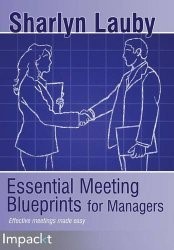 Finally, I would be totally remiss if I didn’t put in a little plug for my book “Essential Meeting Blueprints for Managers.” One of the chapters is dedicated to the networking meeting. It covers everything from using networking meetings to find a job to networking at social events.
Finally, I would be totally remiss if I didn’t put in a little plug for my book “Essential Meeting Blueprints for Managers.” One of the chapters is dedicated to the networking meeting. It covers everything from using networking meetings to find a job to networking at social events.
Got a networking tip? Let us know what works for you in the comments.
The post Quick Shots for #HR and #Business Pros – Conference Networking Edition appeared first on hr bartender.






May 24, 2016
Recruiting Success: Try a Student Loan Benefit Program
(Editor’s Note: Today’s post is brought to you by EdAssist, one of the pioneers in providing education assistance programs that drive employee growth, retention, and engagement. They manage tuition and student loan programs for approximately 160 large employers, handling more than $500 in tuition and loan payments each year. Enjoy the post!)
During this year’s SHRM Talent Management Conference, SHRM CEO Hank Jackson talked about five trends reshaping work. The trends were shifting workforce demographics, loss of middle-skills jobs, skills gaps, fewer physical barriers to work and new models of work. In his comments, he mentioned a new trend in employee benefits: student loan benefit programs.
What are student loan benefit programs?
EdAssist was one of the very first providers to offer student loan benefit programs for large employers so I asked Chris Duchesne, vice president at EdAssist, for a high-level definition. “In its most basic form, student loan assistance means that the company agrees to start making payments against an employee’s student debt. A student loan benefit program may also include help and guidance for employees, including the ability to speak with an advisor about repayment strategies.”
It is distinct from a tuition reimbursement program. One big difference is student loan benefits can apply to degrees acquired prior to entering the workforce, as well as those earned during your career (depending on how the policy is designed).
That being said, many employers are starting to design student loan repayment programs that work in partnership with tuition reimbursement as part of a broader education strategy with similar recruitment and retention aims for degreed workers.
The reason student loans are emerging as an employee benefit
Before we talk about the benefits of a student loan repayment program, let’s take a quick step back and mention how we got here. The cost of tuition has been increasing steadily over the past decade. In the early 90’s, college graduates had very little debt, with the average being around $10,000. Today, the average debt at graduation has tripled to about $35,000.
Meanwhile, organizations continue to struggle finding talent. The Association for Talent Development (ATD) recently reported that 75 percent of CEOs find the skills gap to be the biggest threat to their business. There has to be a way to create a win-win for organizations and employees.
Student loan assistance is a flexible benefit
In learning about EdAssist and their services, I discovered how flexible student loan benefits can be. One of the great things about student loan assistance is that companies can design the program in a way that targets their specific needs for recruitment, engagement, and retention. The thing to remember is that the program should work in unison with other established benefits and fit within the context of company culture.
Student loan benefits help recruit, retain, engage employees in ways that other programs don’t
Click To Tweet
Some people might be thinking, “Why implement a program that has such a narrow audience?” It’s an excellent question. Let’s do some simple math. Statistics show that the nation’s $1.3 trillion in student loan debt is held by about 43 million people. There are approximately 150 million people working in the U.S. – full-time, part-time, etc. So depending on your workplace, it’s possible that 1 in 3 people are in debt.
When I look at it from that lens, it somehow doesn’t seem quite as narrow of an audience. And don’t forget about benefits like parental leave, child care and elder care, all of which have a defined audience.
The benefits of student loan repayment programs
The top concerns in every organization are recruiting, engaging, and retaining talent. Student loan repayment programs can have a positive impact on all three.
Recruitment: We’ve talked before about the challenges facing recruiters. As the market continues to tighten, companies will be looking for ways to close deals with candidates. In the past, that’s often involved signing bonuses. Instead of presenting a check, think about offering candidates a way to get out of debt.
Engagement: I know we don’t like to think of compensation being a factor in employee engagement, but it is. If employees aren’t able make investments like purchase a home, save for retirement, or even get an advanced degree, then money can be a demotivator. Companies like NVIDIA, an EdAssist client, are helping employees pay off their student loans and allowing employees to improve their financial well-being.
Retention: Benefits are definitely a part of the retention conversation. When employees have benefits they value, they stay. Duchesne was quoted in this Kansas City Star article about the impact of retention. “Student loan repayment benefits help with recruiting, retention, engaging employees and driving loyalty in ways that other programs do not.”
Implementing student loan assistance programs
Today’s student loan dynamic is complex. There’s data out there that says nearly 40 percent of borrowers have 3 or more student loans, and 25 percent of borrowers have had a loan switched to a new service in the last 5 years. Oh, that doesn’t’ include borrower confusion about interest rates.
But organizations don’t have to go it alone. This is one of those situations when a strategic partnership with a professional services firm that specializes in student loan assistance programs makes sense. They can help with design, administration, compliance, and consistency. In addition, some providers offer guidance directly to employees to help with an overall repayment plan – which gives the employee more confidence and focus and provides the company with assurance that the payments are going to the best use.
If you want to learn more about student loan repayment programs, I hope you’ll check out this white paper, “Student Loan Benefit Programs: An Innovative Approach to Engagement and Retention.” It’s time for companies to start doing something new. A student loan benefit just might be the answer.
The post Recruiting Success: Try a Student Loan Benefit Program appeared first on hr bartender.






May 22, 2016
The 2016 #FLSA Overtime Changes: What #HR Needs to Know
I’m not going to write a big long explanation for this post. If you’re in the HR world, you know that the much-awaited final ruling came from the U.S. Department of Labor (DOL) about changes to the overtime rule in the Fair Labor Standards Act (FLSA.) Last summer, I spoke with Jonathan Segal, a partner with the law firm Duane Morris LLP regarding the proposed overtime rule changes to the minimum weekly salary requirement and the primary duty test. When I read that the final rules were released, I asked Jonathan if he would give us the scoop. And he very graciously said yes.
I cannot begin to tell you how thankful I am that Jonathan dropped everything to share his initial thoughts with us. He does have a full-time job that keeps him very busy. Please remember that his comments should not be construed as legal advice or as pertaining to any specific factual situations. If you have detailed questions, you should address them directly with your friendly neighborhood labor attorney.
The U.S. Department of Labor final rule regarding overtime came out last week. What are the key provisions of the new rule?
 [Segal] Initially, the DOL proposed effectively $970 per week. In the final rule, the DOL made the weekly minimum salary ‘only’ $913. Even with the reduction from the initial proposal, this is still more than double what the minimum salary currently is under the 2004 regulations.
[Segal] Initially, the DOL proposed effectively $970 per week. In the final rule, the DOL made the weekly minimum salary ‘only’ $913. Even with the reduction from the initial proposal, this is still more than double what the minimum salary currently is under the 2004 regulations.
There is one bit of good news for employers. That is, unlike before, employers now can include certain non-discretionary compensation toward the minimum salary. Specifically, employers can include non-discretionary bonuses, incentive payments and commissions to satisfy up to 10 percent (10%) of the minimum weekly salary.
Also, the DOL had proposed increasing the minimum salary each year. Instead, the DOL, when it finalized the regulations, has mandated increases ‘only’ every three years. Again, this is less than what was feared, but still creates some cost concerns for employers.
The DOL initially had asked a series of questions about the primary duty test. Those questions suggested that the DOL might adopt a percentage approach, like California. Fortunately, the DOL did not adopt a percentage approach. Indeed, it did not change the primary duty test at all. Primary duty still means major or most important. While the standard has not changed, our experience is that the DOL is examining positions more closely.
Reminder: employee gets the benefit of federal or state law, whichever is more protective. Accordingly, California employers remain subject to the percentage test.
There was concern that employers would be given only 60 days to implement. The effective date of the new rules is December 1, 2016. Therefore, employers will have almost six months to prepare.
The 2016 #FLSA Overtime Changes: Here’s What #HR Needs to Know
Click To Tweet
While six months seems like a long time to get ready, the time can pass quickly. What types of activities should human resources professionals do in order to get prepared for the changes?
[Segal] HR professionals are going to need to evaluate carefully a number of options before deciding what to do with each employee whose salary falls below the new minimum salary. There is no ‘one-size-fits-all’ answer to the key question we all will face in deciding whether to raise salaries or to convert to non-exempt.
One factor that an employer will need to consider is the impact of an increase of one employee’s salary on other employees. Should other employees who are above the minimum salary get a boost, too?
If the decision is made to increase the employee’s minimum salary now, the employer needs to know that that salary will continue to rise. Can the employer commit now to future increases?
The employer also needs to consider the employer relations considerations in converting the employee from exempt to non-exempt. For some employees, being converted from exempt to non-exempt will be deemed as a demotion.
Moreover, for many, there will be a loss of flexibility if an employee is converted from exempt to non-exempt. We all know that exempt employees have more flexibility in terms of when and where they get the work done compared to non-exempt employees.
It is not sufficient to say that these employees will lose flexibility. By virtue of their jobs, even if they are reclassified as non-exempt, many of them will need some flexibility.
Therefore, employers will need to develop carefully-crafted recordkeeping plans to allow for some remote work by non-exempt employees who previously were exempt. No remote work may avoid legal claims but it may limit your business. So start thinking about guard rails to limit, capture and pay for all remote work. This is deceptively complex issue so please consult with counsel for legal advice
These are but some of the issues that employers will need to consider as they make the decision whether to increase an employee’s salary or to convert him or her to non-exempt.
One of the considerations you mentioned in the last question are the conversations that the company needs to have with employees who are currently exempt (and will become non-exempt when the rule goes into effect.) What are 2-3 tips that organizations need to consider when speaking with employees?
[Segal] Communication is critical if an employee is converted from exempt to non-exempt. As previously noted, the employee may deem this to be a demotion.
I remember in 2004 when law firm paralegals were told they no longer were professionals and would receive overtime. Notwithstanding the potential to earn more money, many were upset.
It is important for the employer to make clear that the change is driven by law and that the employer does not value any less the contributions that the employees provide. Yes, say it: don’t just think it!
Less is not always more so take the time to explain. That may mean preparing bullet points for your managers if HR cannot handle every meeting.
Another consideration you mentioned was the provision in the final rule that automatically updates the minimum salary requirement levels every three (3) years. How does this increase every 3 years affect the decisions employers make now?
[Segal] Employers need to consider first and foremost how they will get the work done. And, yes, that includes the cost of doing so. In determining cost, employers must consider that there will be increases every 3 years. They will be based on the 40th percentile of full-time employees in the South.
Employers may wish, periodically, to look at data from the Bureau of Labor Statistics (BLS) to determine what the 40th percentile is. That may result in a change in course of action before the mandated increase. Keep in mind that, if you increase an employee’s pay and then convert, the cost of overtime will be substantially higher. As noted earlier, the minimum salary will go up every 3 years. What if you can’t keep up?
As a general rule, an employee’s base rate for overtime is all compensation (subject only to certain enumerated exceptions) divided by 40. The employee usually receives 1.5 times the base rates for overtime hours (that is, over 40). Reminder: in California, it is after 8 hours in a day.
So, let’s assume you raise an employee now from $750 per week to $913 per week and then over the next 3 years to $1,000 per week. But let’s project the number the DOL comes up with 3 years from now is $1,100 per week. Too much, you say?
That’s okay. You can convert the employee to non-exempt at a later date but you will be making overtime payments at a much higher level than if you had converted the employee initially and not later.
Yes, we all will be making judgment calls on imperfect information! But isn’t that what HR does all the time as it balances competing considerations?
Last question, where can HR pros go to learn more about the new regulations and how it impacts them? Is your firm putting together a webinar that readers can register for?
[Segal] SHRM is a wonderful source for information. I learn a great deal not only from the webinars but also from its thought leaders on Twitter, in particular, on this issue, Lisa Horn. You can follow her on Twitter @SHRMLobbyistLisa
And our firm is hosting a number of webinars. Thanks for opportunity to share a link: http://bit.do/b2UL3
A HUGE thanks to Jonathan for sharing his knowledge with us. If you want to stay on top of these changes, be sure to follow him on Twitter @Jonathan_HR_Law or read his blog at Duane Morris. This issue is going to be talked about for some time. It’s important to get the information needed to make the right decisions for your organization.
The post The 2016 #FLSA Overtime Changes: What #HR Needs to Know appeared first on hr bartender.






Sharlyn J. Lauby's Blog
- Sharlyn J. Lauby's profile
- 10 followers



